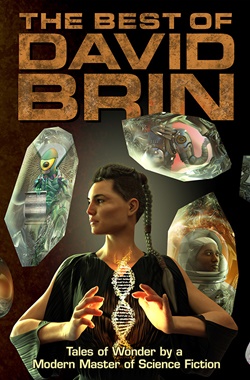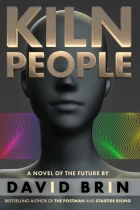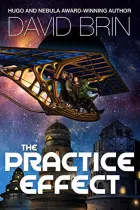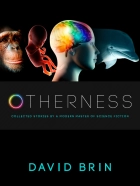Evolutionary biologist Mark Pagel recently spun a fable for The Edge about selection and drift in the human attribute of innovative creativity. His assertion in Infinite Stupidity is that the very same civilization we built through innovation becomes a driving selective force, one that winds up sapping innovative genius from the gene pool.
Now at one level, Professor Pagel’s argument is just a reiteration of the old “marching morons” notion – once popular in 1950s science fiction, as well as the earlier Eugenics Movement – that the long term effect of complex civilization must be to reward mediocrity and propel a decline in net human intelligence.
Pagel starts with a reasonable premise: that as humans created ever-larger societies, featuring rapid communication among greater populations, more people would benefit from copying the innovations produced by a few truly creative individuals.
 So far, that seems pretty obvious. Cultural dissemination of new techniques started really burgeoning about thirty to forty thousand years ago, around the same time that trade networks clearly developed, with seashells adorning necklaces in the Alps, for example.
So far, that seems pretty obvious. Cultural dissemination of new techniques started really burgeoning about thirty to forty thousand years ago, around the same time that trade networks clearly developed, with seashells adorning necklaces in the Alps, for example.
The Neolithic Renaissance, at the dawn of the Aurignacian, erupted with astonishing abruptness after a hundred millennia of static technology. Within a few dozen generations – an eyeblink — our ancestral tool kit expanded prodigiously to include fish hooks and sewing needles made of glistening bone, finely-shaped scrapers, axes, burins, nets, ropes and specialized knives that required many complex stages to create.
Art also erupted on the scene. People adorned themselves with pendants, bracelets and beads. They painted magnificent cave murals, performed burial rituals and carved provocative Venus figurines. Innovation accelerated. So did other deeply human traits – for there appeared clear signs of social stratification. Religion. Kingship. Slavery. War.
And — for the poor Neanderthals — possibly genocide.
What changed?
The cause of this rather rapid shift is hard to confirm, but Pagel seems to be implying (by my interpretation) that it was triggered by something as simple as an expansion of clan size – augmented by increased inter-clan trade.
 So far so good.
So far so good.
Only then Professor Pagel does something I find wholly unjustified, even rather weird. He proposes that – amid this flurry of trade-enhanced innovation – the need for the trait of innovativeness would decline, on a per-capita basis, because the average person or small group would benefit by copying whatever came along.
“As our societies get larger and larger, there’s no need, in fact, there’s even less of a need for any one of us to be an innovator, whereas there is a great advantage for most of us to be copiers, or followers.” In other words, what need to maintain the expensive capacity to create new ideas when you can simply borrow them from a small coterie of idea-guys, scattered across the continent?
Alas, Professor Pagel spins a just-so story that is conveniently and charmingly free of reference to historical or archaeological evidence. For example, he ignores the fact that innovation sped up, intensely and supra-linearly, as the number of individuals connected in a society increased.
According to Pagel’s premise, that rate should not rise appreciably with increased communication! Rather, if the amount of innovation were simply satisfying a Darwinian need, then with an expanded community the per capita creativity resource supplying that need would atrophy until the need was barely met. With the minimally needed level now acquired and satisfied by trade. people would simply become more dull and parasitical – that’s his theory. Only logically it would hold actual-total innovation at the same, pre-trade level.
Toynbee, Marx and Wills
I mentioned that this notion has a long history. Dour folk have long held that civilized life must have negative effects upon the gene pool, leading some, a century ago, to push eugenics legislation. But there are other glimmers from the past that merit mention.
For example, Karl Marx actually praised the cleverness and acumen of the bourgeois capitalist class, deeming them absolutely necessary for economic development. Their competitive creativity (and theft of labor-value from proletarians) would drive capital formation. Cyclically, the actual number of capitalists would see a secular decline with time as their trade networks expanded. In the end, Marx foresaw this brilliant class extinguished, after all the capital was “formed” and when their cleverness was no longer needed. You can see how this eerily mirrors or foreshadows Pagel’s teleology.
Another maven, who comes across better in light of real history, was Arnold Toynbee. His survey of the past led him to conclude that civilizations rise when they support and eagerly learn from their “creative minority” — those who innovate useful solutions to rising problems. And societies fail when they don’t. (In which case, does America’s current war on science… and upon every other clade of mental accomplishment… forebode a coming fall?) In this light, Pagel’s assertion seems dour, indeed.
 A third, more recent voice is Christopher Wills, whose book Children of Prometheus contends that civilization, in fact, rapidly accelerates changes in the gene pool, propelling evolution ever-faster. I believe this case is very well-made, and wholly consistent with what really happened in the era discussed by Professor Pagel.
A third, more recent voice is Christopher Wills, whose book Children of Prometheus contends that civilization, in fact, rapidly accelerates changes in the gene pool, propelling evolution ever-faster. I believe this case is very well-made, and wholly consistent with what really happened in the era discussed by Professor Pagel.
The Great Acceleration
In fact, after the Aurignacian the pace of creativity only sped up, then exponentiated. Agrarian clans and then kingdoms allocated surplus food to specialists, rewarding them for talent and expertise, sometimes in accurate correlation to their effectiveness at innovation. (Though skill at persuasiveness – lying – was always a higher correlate. That trait has almost certainly been an evolutionary rocket; but more on that another time.)
 Key point: with agriculture, the collection and allocation of food surplus became a substantial human reproductive driver, as subsidized specialist roles became common. Competitively striving to attain that status, youths who became scribes, blacksmiths, tool-makers, engineers and priests must have achieved enhanced reproductive ability almost equal to the feudal lords who soon dominated every society.
Key point: with agriculture, the collection and allocation of food surplus became a substantial human reproductive driver, as subsidized specialist roles became common. Competitively striving to attain that status, youths who became scribes, blacksmiths, tool-makers, engineers and priests must have achieved enhanced reproductive ability almost equal to the feudal lords who soon dominated every society.
Hence, a proclivity for nerdiness would increase… though, of course, not quite in pace with an ever-rising tendency toward oligarchy. I’ll admit that the trait most avidly reinforced was the ability of some men to pick up metal implements and take away other men’s women and wheat… a trait that required not only strength but some cleverness and yes, innovation.
Nevertheless, the brain-lackeys – the priests and tool-makers and monument builders – certainly did well. And they passed on the traits that made them successes. So much for the dismally grouchy “marching morons” hypothesis.
All of this is clear from the historical record. I find it disappointing that Professor Pagel seemed so willing to spin us a vague tale without confronting any of it. Indeed, for an evolutionary biologist to weave such a story without referring to reproductive advantage seems very strange, indeed.
A Warning for the Future?
But it isn’t finished. Pagel extrapolates to the modern age: “As our societies get bigger, and rely more and more on the Internet, fewer and fewer of us have to be very good at these creative and imaginative processes. And so, humanity might be moving towards becoming more docile, more oriented towards following, copying others, prone to fads, prone to going down blind alleys, because part of our evolutionary history that we could have never anticipated was leading us towards making use of the small number of other innovations that people come up with, rather than having to produce them ourselves.”
He continues, “What’s happening is that we might, in fact, be at a time in our history where we’re being domesticated by these great big societal things, such as Facebook and the Internet. We’re being domesticated by them, because fewer and fewer and fewer of us have to be innovators to get by. And so, in the cold calculus of evolution by natural selection, at no greater time in history than ever before, copiers are probably doing better than innovators. Because innovation is extraordinarily hard. My worry is that we could be moving in that direction, towards becoming more and more sort of docile copiers.”
“Domesticated?” One is tempted to demand that the professor speak for himself, not this wild spirit!
 But ah, well. So we come down to the couch-potato argument. The question posed by Nicholas Carr and other cyber grouches who contend that Google is making us Stoopid. As I have said before, any sensible person can look around and see plenty of signs that suggest the cynics may be right. Their criticisms may be more inherently useful than the giddy proclamations of cyber-transcendentalists, like Clay Shirky. Criticism is welcome… even if I find both sides romantically unrealistic.
But ah, well. So we come down to the couch-potato argument. The question posed by Nicholas Carr and other cyber grouches who contend that Google is making us Stoopid. As I have said before, any sensible person can look around and see plenty of signs that suggest the cynics may be right. Their criticisms may be more inherently useful than the giddy proclamations of cyber-transcendentalists, like Clay Shirky. Criticism is welcome… even if I find both sides romantically unrealistic.
Nevertheless, look, this is just an assertion, bereft of even correlative evidence, let alone proof. Sure, ninety percent of Internet activity is crap. But that could be said about everything, all the time, even – especially – during all the eras leading up to this one. And while Pagel’s lament may elicit voluptuous schadenfreude, it is hardly utilitarian or helpful.
If civilization relies upon Toynbee’s creative minority, depending on the small percentage of creators more and more, then that minority had better buckle down and find ways to get more support from those marching (copycat) masses. Duh?






























 The Future of “Free” Media
The Future of “Free” Media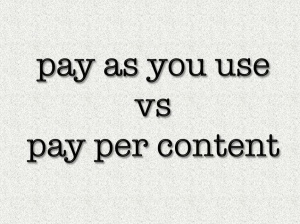 As I see it, there are a few models out there. One is pay as you use… either through fee-entry sites like the NY Times or through content aggregators likeiTunes and the varied Ap stores. The aggregators are likely to expand. Indeed, this is one reason why I am clinging to my AAPL stock, because they are well placed to be leaders in this role.
As I see it, there are a few models out there. One is pay as you use… either through fee-entry sites like the NY Times or through content aggregators likeiTunes and the varied Ap stores. The aggregators are likely to expand. Indeed, this is one reason why I am clinging to my AAPL stock, because they are well placed to be leaders in this role. “I’d pay a nickel for that, but don’t slow me down!” That is the attitude I am hearing.
“I’d pay a nickel for that, but don’t slow me down!” That is the attitude I am hearing. Sometimes Whalen gets silly: “I think everyone is waiting for a GOOG – AAPL face off. It’s not going to happen… AAPL can BUY GOOG.”
Sometimes Whalen gets silly: “I think everyone is waiting for a GOOG – AAPL face off. It’s not going to happen… AAPL can BUY GOOG.”


